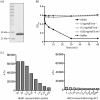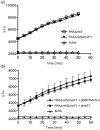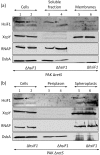Structure-function analysis of HsiF, a gp25-like component of the type VI secretion system, in Pseudomonas aeruginosa
- PMID: 21873404
- PMCID: PMC3352280
- DOI: 10.1099/mic.0.051987-0
Structure-function analysis of HsiF, a gp25-like component of the type VI secretion system, in Pseudomonas aeruginosa
Abstract
Bacterial pathogens use a range of protein secretion systems to colonize their host. One recent addition to this arsenal is the type VI secretion system (T6SS), which is found in many Gram-negative bacteria. The T6SS involves 12-15 components, including a ClpV-like AAA(+) ATPase. Moreover, the VgrG and Hcp components have been proposed to form a puncturing device, based on structural similarity to the tail spike components gp5/gp27 and the tail tube component gp19 of the T4 bacteriophage, respectively. Another T6SS component shows similarity to a T4 phage protein, namely gp25. The gp25 protein has been proposed to have lysozyme activity. Other T6SS components do not exhibit obvious similarity to characterized T4 phage components. The genome of Pseudomonas aeruginosa contains three T6SS gene clusters. In each cluster a gene encoding a putative member of the gp25-like protein family was identified, which we called HsiF. We confirmed this similarity by analysing the structure of the P. aeruginosa HsiF proteins using secondary and tertiary structure prediction tools. We demonstrated that HsiF1 is crucial for the T6SS-dependent secretion of Hcp and VgrG. Importantly, lysozyme activity of HsiF proteins was not detectable, and we related this observation to the demonstration that HsiF1 localizes to the cytoplasm of P. aeruginosa. Finally, our data showed that a conserved glutamate, predicted to be required for proper HsiF folding, is essential for its function. In conclusion, our data confirm the central role of HsiF in the T6SS mechanism, provide information on the predicted HsiF structure, and call for reconsideration of the function of gp25-like proteins.
Figures







Similar articles
-
Type VI secretion system in Pseudomonas aeruginosa: secretion and multimerization of VgrG proteins.J Biol Chem. 2011 Apr 8;286(14):12317-27. doi: 10.1074/jbc.M110.193045. Epub 2011 Feb 16. J Biol Chem. 2011. PMID: 21325275 Free PMC article.
-
The HsiB1C1 (TssB-TssC) complex of the Pseudomonas aeruginosa type VI secretion system forms a bacteriophage tail sheathlike structure.J Biol Chem. 2013 Mar 15;288(11):7536-7548. doi: 10.1074/jbc.M112.439273. Epub 2013 Jan 22. J Biol Chem. 2013. PMID: 23341461 Free PMC article.
-
Coevolution of the ATPase ClpV, the sheath proteins TssB and TssC, and the accessory protein TagJ/HsiE1 distinguishes type VI secretion classes.J Biol Chem. 2014 Nov 21;289(47):33032-43. doi: 10.1074/jbc.M114.600510. Epub 2014 Oct 10. J Biol Chem. 2014. PMID: 25305017 Free PMC article.
-
Composition, function, and regulation of T6SS in Pseudomonas aeruginosa.Microbiol Res. 2015 Mar;172:19-25. doi: 10.1016/j.micres.2015.01.004. Epub 2015 Jan 7. Microbiol Res. 2015. PMID: 25721475 Review.
-
The type VI secretion system: translocation of effectors and effector-domains.Curr Opin Microbiol. 2009 Feb;12(1):11-7. doi: 10.1016/j.mib.2008.11.010. Epub 2009 Jan 21. Curr Opin Microbiol. 2009. PMID: 19162533 Review.
Cited by
-
Genetic Dissection of the Type VI Secretion System in Acinetobacter and Identification of a Novel Peptidoglycan Hydrolase, TagX, Required for Its Biogenesis.mBio. 2016 Oct 11;7(5):e01253-16. doi: 10.1128/mBio.01253-16. mBio. 2016. PMID: 27729508 Free PMC article.
-
Systematic dissection of the agrobacterium type VI secretion system reveals machinery and secreted components for subcomplex formation.PLoS One. 2013 Jul 5;8(7):e67647. doi: 10.1371/journal.pone.0067647. Print 2013. PLoS One. 2013. PMID: 23861778 Free PMC article.
-
Baseplate Component TssK and Spatio-Temporal Assembly of T6SS in Pseudomonas aeruginosa.Front Microbiol. 2019 Jul 18;10:1615. doi: 10.3389/fmicb.2019.01615. eCollection 2019. Front Microbiol. 2019. PMID: 31379775 Free PMC article.
-
Structural basis for inhibition of a response regulator of σS stability by a ClpXP antiadaptor.Genes Dev. 2019 Jun 1;33(11-12):718-732. doi: 10.1101/gad.320168.118. Epub 2019 Apr 11. Genes Dev. 2019. PMID: 30975721 Free PMC article.
-
Distribution of genes related to Type 6 secretion system and lipooligosaccharide that induced ganglioside mimicry among Campylobacter jejuni isolated from human diarrhea in Thailand.Gut Pathog. 2020 Apr 9;12:18. doi: 10.1186/s13099-020-00357-6. eCollection 2020. Gut Pathog. 2020. PMID: 32308743 Free PMC article.
References
Publication types
MeSH terms
Substances
Grants and funding
LinkOut - more resources
Full Text Sources
Molecular Biology Databases
Miscellaneous

